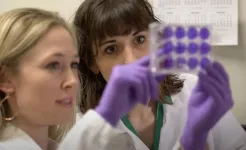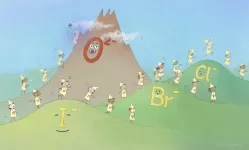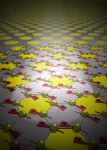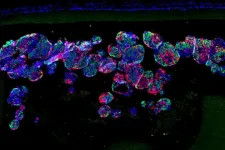CMU Team develops machine learning platform that mines nature for new drugs
2021-06-02
(Press-News.org) Researchers from Carnegie Mellon University's Computational Biology Department in the School of Computer Science have developed a new process that could reinvigorate the search for natural product drugs to treat cancers, viral infections and other ailments.
The machine learning algorithms developed by the Metabolomics and Metagenomics Lab match the signals of a microbe's metabolites with its genomic signals and identify which likely correspond to a natural product. Knowing that, researchers are better equipped to isolate the natural product to begin developing it for a possible drug.
"Natural products are still one of the most successful paths for drug discovery," said Bahar Behsaz, a project scientist in the lab and lead author of a paper about the process. "And we think we're able to take it further with an algorithm like ours. Our computational model is orders of magnitude faster and more sensitive."
In a single study, the team was able to scan the metabolomics and genomic data for about 200 strains of microbes. The algorithm not only identified the hundreds of natural product drugs the researchers expected to find, but it also discovered four novel natural products that appear promising for future drug development. The team's work was published recently in Nature Communications.
The paper, "Integrating Genomics and Metabolomics for Scalable Non-Ribosomal Peptide Discovery," outlines the team's development of NRPminer, an artificial intelligence tool to aid in discovering non-ribosomal peptides (NRPs). NRPs are an important type of natural product and are used to make many antibiotics, anticancer drugs and other clinically used medications. They are, however, difficult to detect and even more difficult to identify as potentially useful.
"What is unique about our approach is that our technology is very sensitive. It can detect molecules with nanograms of abundance," said Hosein Mohimani, an assistant professor and head of the lab. "We can discover things that are hidden under the grass."
Most of the antibiotic, antifungal and many antitumor medications discovered and widely used have come from natural products.
Penicillin is among the most used and well-known drugs derived from natural products. It was, in part, discovered by luck, as are many of the drugs made from natural products. But replicating that luck is difficult in the laboratory and at scale. Trying to uncover natural products is also time and labor intensive, often taking years and millions of dollars. Major pharmaceutical companies have mostly abandoned the search for new natural products in the past decades.
By applying machine learning algorithms to the study of genomics, however, researchers have created new opportunities to identify and isolate natural products that could be beneficial.
"Our hope is that we can push this forward and discover other natural drug candidates and then develop those into a phase that would be attractive to pharmaceutical companies," Mohimani said. "Bahar Behsaz and I are expanding our discovery methods to different classes of natural products at a scale suitable for commercialization."
The team is already investigating the four new natural products discovered during their study. The products are being analyzed by a team led by Helga Bode, head of the Institute for Molecular Bioscience at Goethe University in Germany, and two have been found to have potential antimalarial properties.
INFORMATION:
This study was conducted in collaboration with researchers from the University of California San Diego; Saint Petersburg University; the Max-Planck Institute; Goethe University; the University of Wisconsin, Madison; and the Jackson Laboratory.
ELSE PRESS RELEASES FROM THIS DATE:
2021-06-02
A team of Colorado State University scientists, led by veterinary postdoctoral fellow Dr. Anna Fagre, has detected Zika virus RNA in free-ranging African bats. RNA, or ribonucleic acid, is a molecule that plays a central role in the function of genes.
According to Fagre, the new research is a first-ever in science. It also marks the first time scientists have published a study on the detection of Zika virus RNA in any free-ranging bat.
The findings have ecological implications and raise questions about how bats are exposed to Zika virus in nature. The study was recently published in Scientific Reports, a journal published by Nature Research.
Fagre, a researcher at CSU's Center for Vector-Borne Infectious Diseases, ...
2021-06-02
ITHACA, N.Y. - All fish are not created equal, at least when it comes to nutritional benefits.
This truth has important implications for how declining fish biodiversity can affect human nutrition, according to a computer modeling study led by Cornell and Columbia University researchers.
The study, "Declining Diversity of Wild-Caught Species Puts Dietary Nutrient Supplies at Risk," published May 28 in Science Advances, focused on the Loreto region of the Peruvian Amazon, where inland fisheries provide a critical source of nutrition for the 800,000 inhabitants.
At the same time, the findings apply to fish biodiversity worldwide, as more than 2 billion people depend on fish as their primary source of animal-derived nutrients.
"Investing in safeguarding biodiversity can deliver ...
2021-06-02
Researchers at Kyoto University's Institute for Cell-Material Sciences (iCeMS) have developed a new approach to speed up hydrogen atoms moving through a crystal lattice structure at lower temperatures. They reported their findings in the journal Science Advances.
"Improving hydrogen transport in solids could lead to more sustainable sources of energy," says Hiroshi Kageyama of iCeMS who led the study.
Negatively charged hydrogen 'anions' can move very quickly through a solid 'hydride' material, which consists of hydrogen atoms attached to other chemical elements. This system is a promising contender for clean energy, but the fast ...
2021-06-02
Stone tools have been made by humans and their ancestors for millions of years. For archaeologists these rocky remnants - lithic artefacts and flakes - are of key importance. Because of their high preservation potential they are among the most common findings in archaeological excavations. Worldwide, numerical dating of these lithic artefacts, especially when they occur as surface findings, remains a major challenge. Usually, stone tools cannot be dated directly, but only when they are embedded in sediment layers together with, for example, organic material. The age of such organic material can be constrained via the radiocarbon technique. If such datable organic remains are ...
2021-06-02
Tested on human blood in the lab, the selective nanocapsules could reduce the side effects of a major blood clot dissolving drug, which include bleeding on the brain. If confirmed with animal tests, the nanocapsules could also make the drug more effective at lower doses.
Blood clots, also known as thrombi, are a key cause of strokes and heart attacks which are leading causes of death and ill-health worldwide. They can be treated with a clot dissolving drug called tissue plasminogen activator (tPA) which disrupts clots to clear the blocked blood vessel and re-establish blood ...
2021-06-02
Known as nature's own sonar system, echolocation occurs when an animal emits a sound that bounces off objects in the environment, returning echoes that provide information about the surrounding space.
While echolocation is well known in whale or bat species, previous research has also indicated that some blind people may use click-based echolocation to judge spaces and improve their navigation skills.
Equipped with this knowledge, a team of researchers, led by Dr Lore Thaler, of Durham University, UK, delved into the factors that determine how people learn this skill.
Over the course of a 10-week training programme, the team investigated how blindness and age affect learning ...
2021-06-02
Atomically thin van der Waals magnets are widely seen as the ultimately compact media for future magnetic data storage and fast data processing. Controlling the magnetic state of these materials in real-time, however, has proven difficult. But now, an international team of researchers led by Delft University of Technology (TU Delft) has managed to use light in order to change the anisotropy of a van der Waals antiferromagnet on demand, paving the way to new, extremely efficient means of data storage.
The thin atomic layers that make up van der Waals magnets may seem extremely fragile, but they can be about 200 times stronger ...
2021-06-02
In a six-month study of more than 1,000 Americans, R. Kelly Garrett and Robert Bond found that U.S. conservatives were less able to distinguish truth from falsehoods in 20 viral political news stories that appeared online between January and July 2019. Differences in the political orientation of these stories may help explain this observation, the researchers note, writing that "we find that high-profile true political claims tend to promote issues and candidates favored by liberals, while falsehoods tend to be better for conservatives." Two-thirds (65%) of the high-profile true stories were characterized as benefiting the political left, compared with only 10% that were described as benefiting the political right. Among high-profile false stories, 45.8% were perceived to benefit the ...
2021-06-02
Individuals at higher risk of developing pancreatic cancer could be identified earlier using machine learning (ML) techniques which would result in a greater number of patients surviving the disease, suggests a new study published in PLOS ONE.
The study was led by the London School of Hygiene & Tropical Medicine (LSHTM) and funded by the UK charity Pancreatic Cancer Research Fund (PCRF).
It used UK electronic health records for more than 1,000 patients aged 15-99 years who were diagnosed with pancreatic cancer between January 2005 and June 2009.
The researchers examined numerous symptoms and ...
2021-06-02
A team of researchers led by diabetes specialists and biomedical engineers at Washington University School of Medicine in St. Louis and Cornell University has demonstrated that, using a miniscule device, they can implant insulin-secreting cells into diabetic mice. Once implanted, the cells secrete insulin in response to blood sugar, reversing diabetes without requiring drugs to suppress the immune system.
The findings are published June 2 in the journal Science Translational Medicine.
"We can take a person's skin or fat cells, make them into stem cells and then grow those stem cells into insulin-secreting cells," said Jeffrey R. Millman, PhD, an associate professor of medicine at Washington ...
LAST 30 PRESS RELEASES:
[Press-News.org] CMU Team develops machine learning platform that mines nature for new drugs




